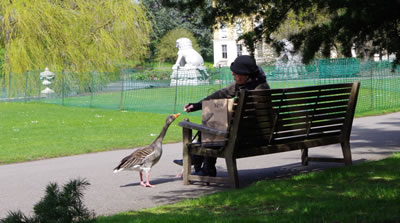Earth Day is an international holiday that promotes environmental awareness. It is celebrated on April 22 every year.
People observe Earth Day by encouraging actions to help preserve the environment - such as recycling, planting trees and walking or riding bicycles instead of driving cars.
They look for ways to combat the dangerous effects of processes like climate change and habitat destruction.
 Some people celebrate Earth Week, and spend an entire week taking part in pro-environment activities.
Some people celebrate Earth Week, and spend an entire week taking part in pro-environment activities.
In some places, Earth Day is held a month earlier, at the Spring Equinox.
History
The first Earth Day took place in the United States on April 22, 1970.
Earth Day was founded by U.S. Senator Gaylord Nelson.
During the 1960s, Senator Nelson developed serious concerns about the environment and traveled around the United States speaking about his concerns.
Toward the end of the decade, he became influenced by the actions of Vietnam War protesters.
He began to believe that there should be a national grassroots movement protesting the damage that was being done to the environment, similar to the movement protesting the activities taking place in Vietnam.
In late 1969, at a conference in Seattle, Nelson announced that a large pro-environment demonstration would take place the following year. Nelson's announcement quickly spread throughout the media.
Soon, with support from Congressman Peter McCloskey, a day of protests began to take shape. The day was organized by Denis Hayes.
On April 22, 1970, rallies and demonstrations protesting the destruction of the environment took place across the United States. Approximately 20 million people took part in what became the first Earth Day.
Protestors brought attention to the problems caused by oil spills, pesticides, the expansion of freeways, toxic dumps, industrial pollution and other threats to the environment. They protested increasing levels of species extinction.
The size of the protests made legislators realize that concern for the environment was shared by people of many different economic, political and religious backgrounds. Environmental awareness was not just something for hippies.
Soon, important pieces of pro-environment legislation were enacted.
In December 1970, the Environmental Protection Agency (EPA) was created.
The Clean Air At was passed at the end of the month.
This was followed by the Clean Water Act, which was passed in 1972, and the Endangered Species Act, which was passed in 1973.
In 1990, Hayes coordinated a campaign to make Earth Day a global phenomenon. People from 141 countries around the world were involved in Earth Day 1990.
With international awareness of issues confronting the environment increasing, international organizations began making the environment a priority
Two years later, in 1992, the first international Earth Summit, coordinated by the United Nations, took place in Rio de Janeiro, Brazil.
Senator Nelson was given the Presidential Medal of Freedom in 1995. He was given the medal in recognition of all that he had accomplished by creating Earth Day.
In 2009, the UN General Assembly proclaimed April 22 to be International Mother Earth Day.
Earth Day 2014
We often hear about how humans are destroying the Earth and the living things on it, whether by hunting, destroying habitats or burning fossil fuels.

In honor of Earth Day 2014, here are 5 ways people are making our world a better place.
1. Recycling
There’s a big push toward recycling around Earth Day, but nowadays, for many of us, recycling has become a habit. Many people wouldn’t dream of throwing a plastic bottle in the trash, Earth Day or any day of the year. In 2011, twice as many Americans recycled as did 20 years before.
2. Finding alternative sources of energy
Many of us are concerned with how burning fossil fuels damages the environment, contributes to climate change and promotes political instability that can lead to war. Many of us are already doing something about it, whether by installing solar panels or promoting the development of wind power.
3. Growing things
People often celebrate Earth day by planting trees. However, people are planting things all the time, whether they plant trees in a public park, grow vegetables in a garden or orchids in a flowerpot in a window. Plants not only improve air quality by filtering pollution and reducing carbon dioxide levels, their presence helps us get rid of stress and makes us feel happy.
4. Taking care of other animals
Human beings have been caring for pets, starting with dogs, for more than 15,000 years. Sometimes, we give them as much attention, care and love as we do our own children. We rescue abandoned animals and animals with special needs. We spay and neuter pets to prevent overpopulation.
We also feed strays and wild birds, plant trees for other birds and other animals to live in, strive to keep rivers and lakes free from pollutants so fish and other creatures can thrive and create laws to protect endangered species—proving that we don't need to "own" animals in order care for them.
5. Doing medical research
Infectious diseases can sometimes be transmitted between humans and other animal species, so work towards eliminating these diseases benefits all animals. In addition, some medical conditions, like diabetes, can affect many different species, and research on how to cure or prevent these conditions can help all of them.
By developing the ability to culture tissues from stem cells, we've given scientists a way to do medical research without experimenting on animals.
We Homo sapiens may not be perfect, but some of the things we're doing aren't that bad.
Happy Earth Day!
(Photo Credit: Dinkum, Creative Commons CC0 1.0 Universal Public Domain Dedication)